

 |
 |
|||||||||||||||||||||||||||||
| START GERMAN FOTOALBEN WALLPAPER LINKS CONTACT | ||||||||||||||||||||||||||||||
|
|
|
|
|
|
|
|
|
|
|
|
|
|
|
|
|
|
|
|
|
|
|
|
|
|
||
| The project: The Darulaman Palace | ||||||||||||||||||||||||||
|
||||||||||||||||||||||||||
| "The Darulaman Palace nearing completion." | ||||||||||||||||||||||||||
| Please move the cursor over the photo to see the palace badly damaged by an artillery attack in 1995. | ||||||||||||||||||||||||||
 |
||||||||||||||||||||||||||
| Based on the shadow cast of the palace, it can be calculated that my great-grandfather took the picture in the late afternoon. | ||||||||||||||||||||||||||
| Please note the bridge with the four turtles. As you can see in current pictures, only the concrete slab remains from the bridge. The rest, like the rest of the country, was destroyed. | ||||||||||||||||||||||||||
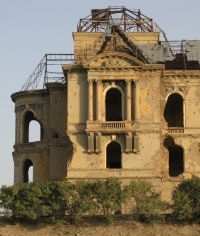 Amanullah Khan wanted to modernize Afghanistan from his palace and bring prosperity and peace. Of course, it was necessary to bring the country under control. This project is also reflected in the location of the Darulaman Palace or the plan according to which the individual rooms should be used. Interesting is the street escape in the Amanullah Khan his office and let build his palace. The main streets of Kabul and the road to the east and south-east form an intersection. Interestingly, this point of intersection is not in the middle of the palace or the rotunda, which was once to be the boardroom of Parliament, but in Amanullah Khan's office. From his office, the king had a direct view of the traffic of the three streets. |
||||||||||||||||||||||||||
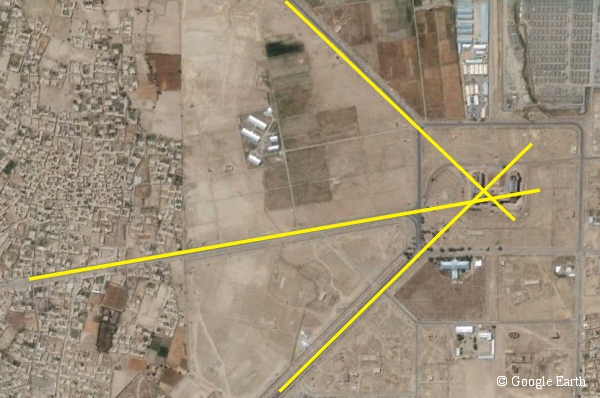  |
||||||||||||||||||||||||||
| - and the Tape Taj Beg palace | ||||||||||||||||||||||||||
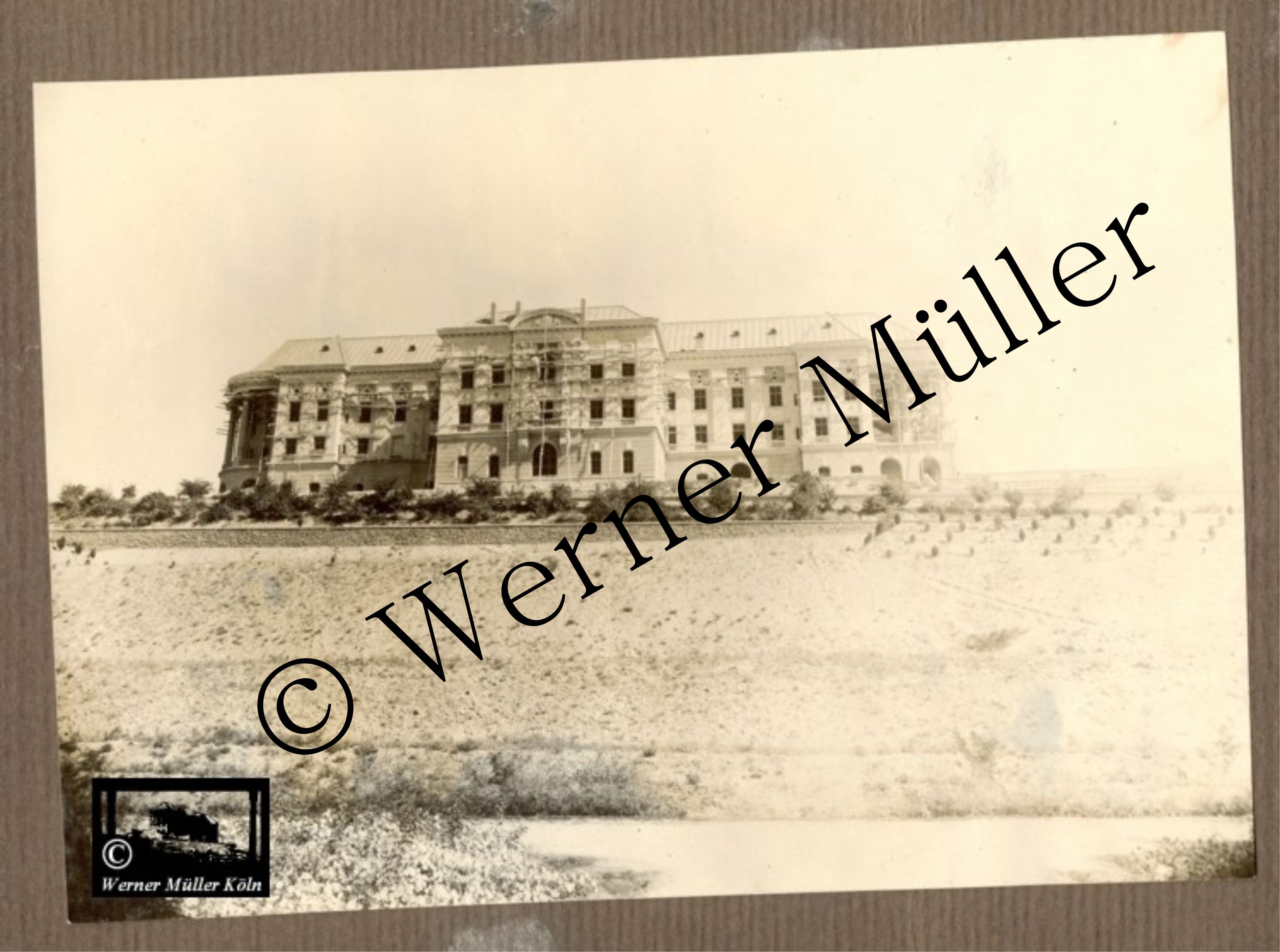 |
||||||||||||||||||||||||||
| The Tape Taj Beg Palace nearing completion. In places, the scaffolding is still attached to the building. The picture was taken from the south to the palace. | ||||||||||||||||||||||||||
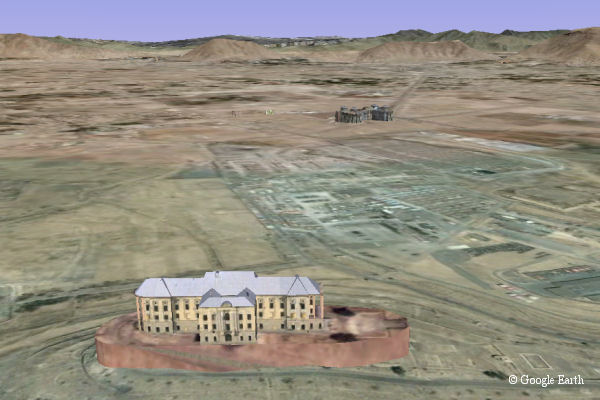 As
with the layouts of the Dar-ul-Aman Palace, the planning of the Tapeh Taj
Beg Palace is based on the direct claims of Amanullah Khan. From a large
hall (red) one has direct view of the Darulaman palace and in the distance
on Kabul. The private living area is oriented towards the south-facing
mountain range. This also has the advantage that in winter the premises
heat up faster on the sunny side. As
with the layouts of the Dar-ul-Aman Palace, the planning of the Tapeh Taj
Beg Palace is based on the direct claims of Amanullah Khan. From a large
hall (red) one has direct view of the Darulaman palace and in the distance
on Kabul. The private living area is oriented towards the south-facing
mountain range. This also has the advantage that in winter the premises
heat up faster on the sunny side.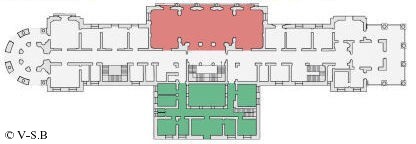
|
||||||||||||||||||||||||||
 |
||||||||||||||||||||||||||
| A photo from 1926. At the palace he worked (far right) as one of the "Darulaman gentlemen". On the back of the photo he also uses the spelling Dar-ul-aman. | ||||||||||||||||||||||||||
| On the back of the photo he noted: "The Dar-ul-aman - Gentlemen 1926 [from the left] Buchholz - Saturday manager Parron - Hartlieb - Rieck [sitting:] Harten-Standke " | ||||||||||||||||||||||||||
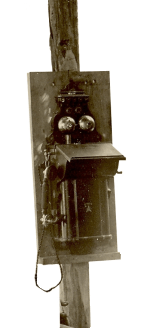 |
||||||||||||||||||||||||||
| The year 1926 is one of the few years in his photo albums. | ||||||||||||||||||||||||||
"The
Darulaman-gentlemen" "1926" |
||||||||||||||||||||||||||
| There are several spellings for the name of the Afghan government district. So z. For example, the foundation " Darul-aman". I take over the writing of my great-grandfather that he used for his picture descriptions for this story: Darulaman . | ||||||||||||||||||||||||||
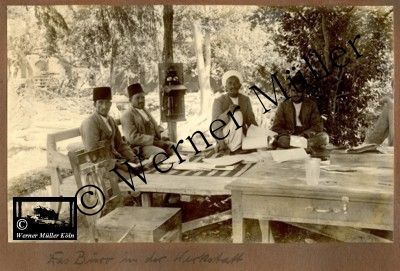 |
||||||||||||||||||||||||||
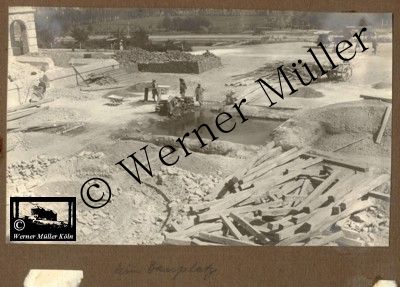 |
||||||||||||||||||||||||||
| "The office in the workshop" | ||||||||||||||||||||||||||
 |
||||||||||||||||||||||||||
|
"At the construction site" in the courtyard of the Darulaman Palace |
||||||||||||||||||||||||||
| My great-grandfather did not write Darulaman Palace in another photo but "Government Palace". | ||||||||||||||||||||||||||
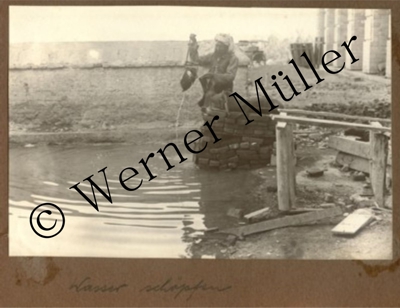 |
||||||||||||||||||||||||||
| "Locksmith and blacksmith staff" | ||||||||||||||||||||||||||
| Like Dr. Gerber writes in his book "Afghan Mosaics", not only German architects and engineers worked in the palace, but also German craftsmen. This in turn trained hundreds of Afghan craftsmen (according to Emil Trinkler). | ||||||||||||||||||||||||||
 |
||||||||||||||||||||||||||
|
"Get water"
In the background on the right is a column row of the government palace. |
||||||||||||||||||||||||||
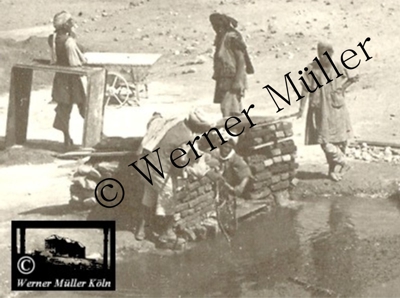 |
||||||||||||||||||||||||||
| "Plumber and blacksmith" | ||||||||||||||||||||||||||
| The waterhole from the other side. | ||||||||||||||||||||||||||
| Here are some details from the construction site. The excerpts are in the photo "At the construction site" which is shown above. My great-grandfather was probably on the first floor of the central building and photographed the left inner courtyard from there. The waterhole could be the later square fountain that can still be seen today. | ||||||||||||||||||||||||||
| "Gateway to the Government Palace" | ||||||||||||||||||||||||||
| If you move the cursor over the image, you will see that the image was taken during the construction phase. The roof is not covered yet. | ||||||||||||||||||||||||||
| Also interesting are the construction rails that line the street behind the palace. It could be dozers of Hentschel. | ||||||||||||||||||||||||||
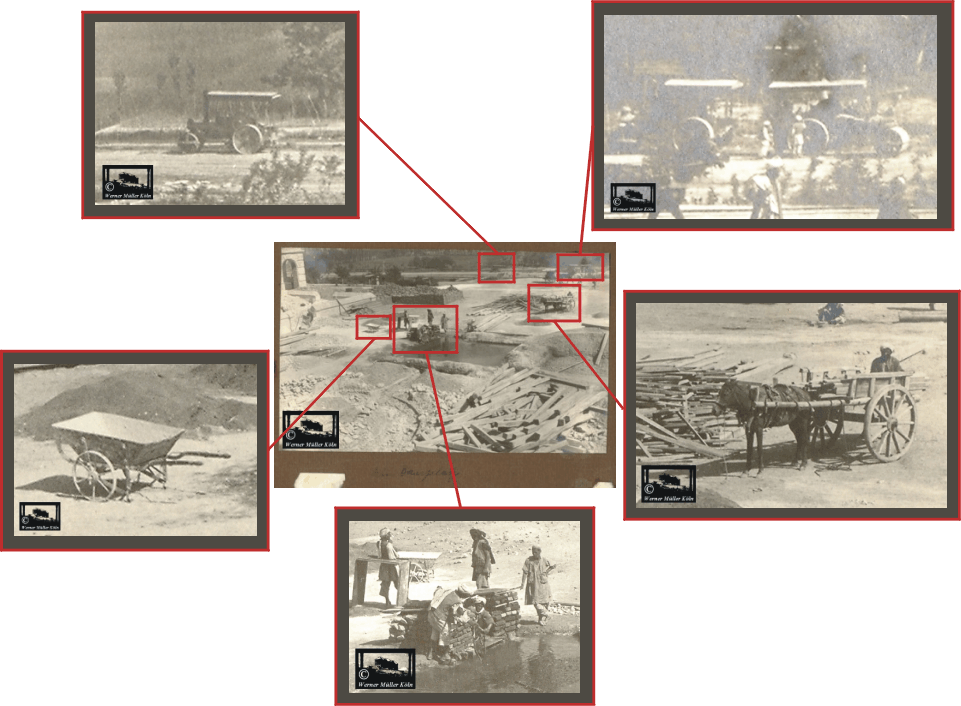 |
||||||||||||||||||||||||||
|
The Germans were involved in many projects
at that time. In addition to a dam in northwest Kabul, a bridge was built
over the Kabul - today's Hortenbrücke. 1924 but also a school was built.
This German school was to prepare Afghan students for study in Germany.
But it was also intended for the children of Germans who lived in
Afghanistan. For example, the Afghan government asked my great-grandfather
if it would be possible for the entire family to move. As an offer was
also mentioned that there would be a German school for the daughter.
Whether my great-grandfather was involved in the construction of the
former German School, I do not know, but it is likely. This school still exists today and is now called Amani-Oberrealschule. The school was rebuilt with German help. |
||||||||||||||||||||||||||
| Another project of King Amanullah can be seen in the following photo. It is the first railway in Afghanistan that he had built from his seat of government Darulaman to Kabul. Conservative forces regarded the railroad as a devil's craft because a fire was burning inside the locomotives. It's also very interesting that he wrote extra on the back: "Railway Darulaman - Kabul first official trip (without any government representative) Afghanistan". Why did not any government officials participate in this important achievement of Afghanistan? | ||||||||||||||||||||||||||
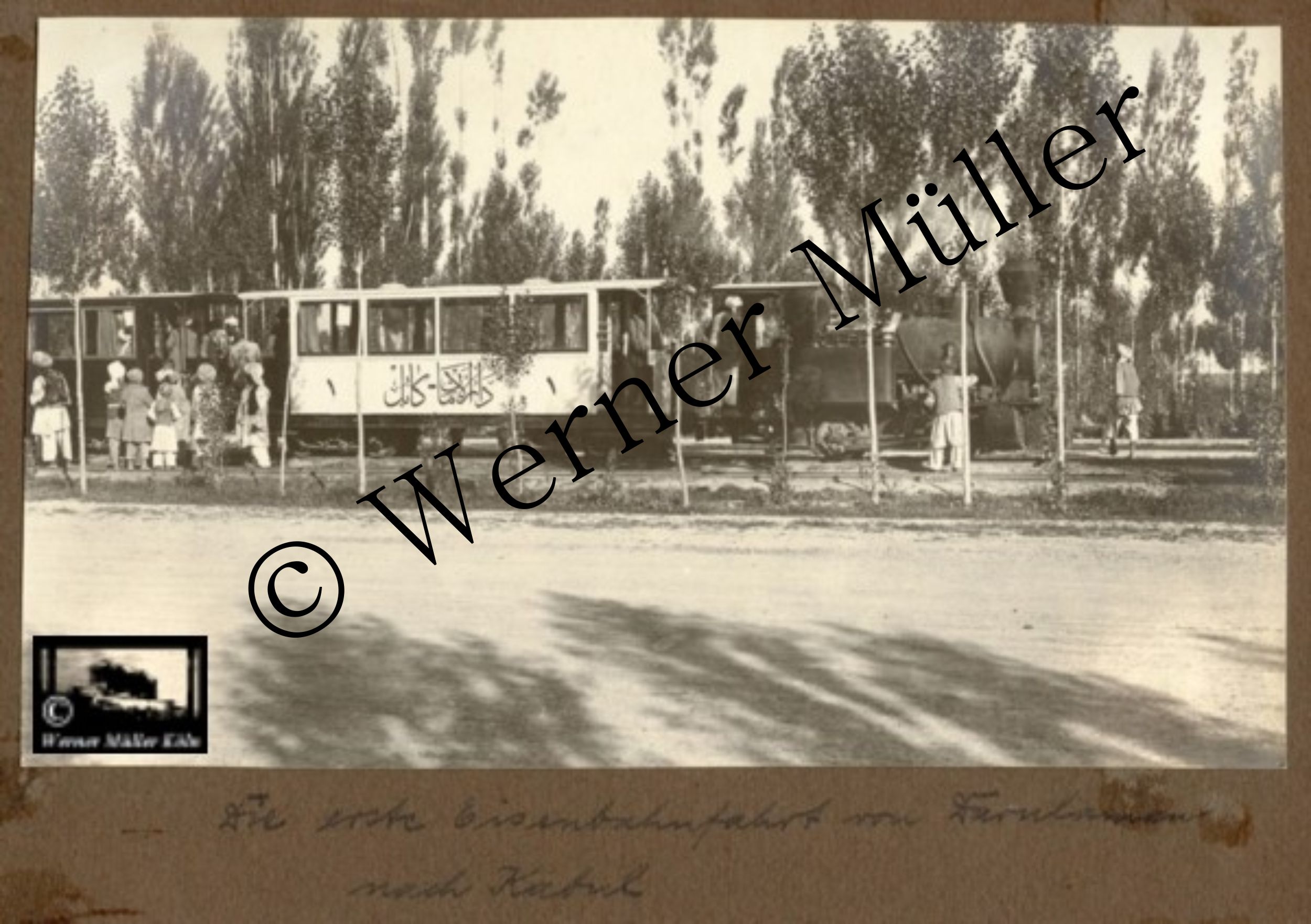 |
||||||||||||||||||||||||||
"First
official journey from Darulaman to Kabul" |
||||||||||||||||||||||||||
| It is also interesting what he wrote on the backside | ||||||||||||||||||||||||||
|
Railway Darulaman - Kabul
first official trip (without any government representative) Afghanistan |
||||||||||||||||||||||||||
| Here are three of six locomotives they look like in 2003. At that time, the locomotives were set up in front of the National Museum opposite the Darulaman Palace and were totally rusted over the years. In the meantime, the locomotives of the German Armed Forces forces were loaded onto vans by the ISAF and taken to a safe place where they hopefully will no longer be exposed to the weather. | ||||||||||||||||||||||||||